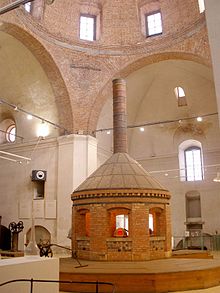Real Fábrica de Cristales de La Granja
The Real Fábrica de Cristales de La Granja is a historic royal glass manufacturer in the city of San Ildefonso in the province of Segovia . The entire factory is a listed building and was entered on the Bien de Interés Cultural list in 1997 . The total rectangular area of the Real Fábrica de Cristales building complex is around 24,500 m² and is now part of the Museo del Vidrio Segovia .
history
The glass factory was built in the 17th century by order of the King of Spain Felipe V de Borbón and from 1720 manufactured the various colored glass windows and the numerous mirrors for the royal palaces for the king's summer residence, the Palacio Real La Granja de San Ildefonso . The first melting tank for flat glass production had dimensions of 3.5 × 2 meters.
In 1746, the Real Fábrica began manufacturing drinking glasses, bottles and glassware under the direction of the French glassmaker Dionisio Sibert . Around 1750, the German glassmaker Johann Eder (1694–1753) introduced lead crystal glass production . Eder installed the harbor furnace , which is still in existence today, to simultaneously melt small quantities such as colored glass, tumbler or special glasses in small crucibles. Eder also introduced the manufacture of high-quality colored lead crystal glasses, which were produced using the so-called overlay technique. During the manufacturing process, he covered transparent glass with liquid glass of a different color and then shaped it. The glass factory set up and managed by Johann Eder in San Ildefonso, which the king called "Fábrica de Entrefinos", was a technologically and economically successful company, which after Eder's death in 1753 was continued and flourished by his son Joseph and international recognition.
During the time of King Fernando VII , the royal glass manufacture was further expanded in 1814, but due to the beginning of industrial glass production at the end of the 18th century, it had to give up the now expensive glass-blowing workshop.
In 1911 the Cooperativa Obrera Esperanza was founded, which began again with the production of flat glass in the rented building. In 1963, after the production of glass wool was also unsuccessful, the history of the Real Fábrica de Cristales de La Granja ended.
today
Since 1982 the former building of the Real Fábrica de Cristales has been the seat of the Fundación Centro Nacional de Vidrio with the attached glass laboratory with library and the Museo del Vidrio as well as a glass workshop Escuela-Taller de Vidrio , in which today the old traditional art of hand-blown glasses is demonstrated and courses are given. Since 2007 the building of the former glass factory has also housed the IES Penalara Institute and a sales room where historical glasses can be purchased.
Escuela-Taller de Vidrio
The handcrafted glasses are now made manually by a master glassblower using historical shapes and using the same methods as their predecessors, the Royal Glass Factory. The finished pieces are handmade and have irregularities that can appear due to the handcraft.
Web links
literature
Individual evidence
Coordinates: 40 ° 54 '12.1 " N , 4 ° 0' 23.2" W.

